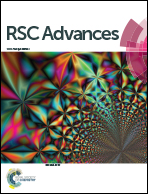Removal of abamectin and conventional pollutants in vertical flow constructed wetlands with Fe-modified biochar†
Abstract
To improve the ability of constructed wetlands to remove abamectin (ABM) and nutrients, the influence of four different substrates on constructed wetlands was studied. Four vertical up-flow constructed wetlands (UVCWs) were established to treat simulated agricultural wastewater: CW1 (quartz sand + pebbles), CW2 (pebbles + coke), CW3 (Fe-modified biochar + pebbles + coke), and CW4 (unmodified biochar + pebbles + coke). Under different combinations of hydraulic loading and organic loading, CW3 was extremely effective at removing nitrogen compared with CW1, CW2 and CW4. We found that CW3 was the most effective at treating ABM and conventional pollutants. The highest efficiency of removal of abamectin (99%), COD (98%), NH4+–N (65%), and TP (80%) was obtained in CW3. These results were directly verified by microbiological tests and microbial community analysis. The microbial diversity of CW3 and CW4 was significantly higher than those of CW1 and CW2. Fe-modified biochar provides a feasible and effective amendment for constructed wetlands to improve the nitrogen removal for C/N (2.5 : 1–5 : 1) wastewater by the ability of microbes to remove nitrogen. Fe-modified bamboo charcoal can be used in engineering as a new type of green environmental protection constructed wetland filler in the future.



 Please wait while we load your content...
Please wait while we load your content...